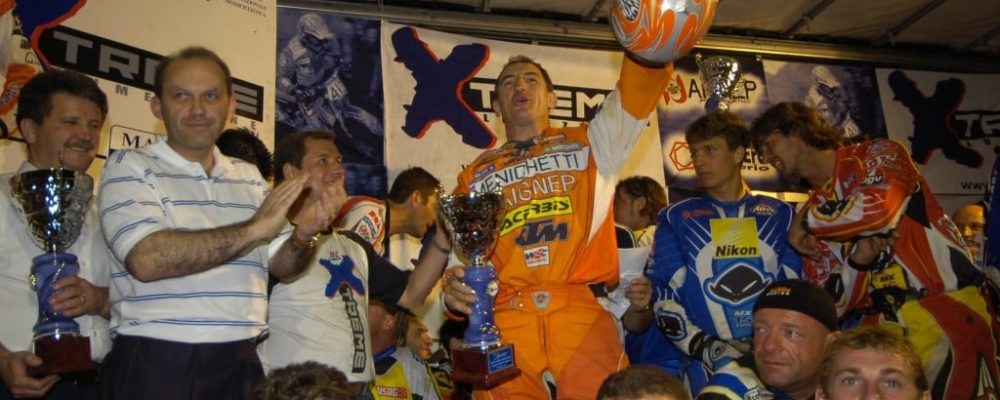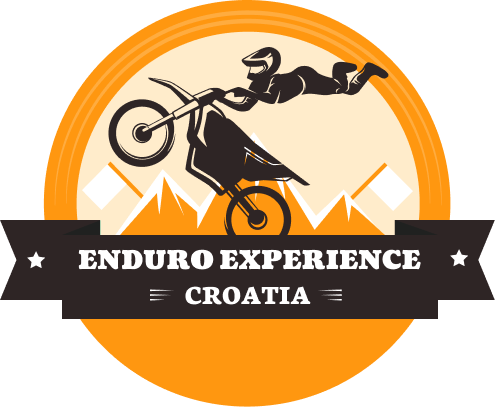We were super lucky to meet Gio Sala, Italy’s best-loved enduro rider and multiple enduro world champion. We obviously took the opportunity to ask him a few questions and discovered some really interesting things about him which we are happy to share with you. So if you want to know his story and also have a piece of his advice….continue reading.
1. Gio, I’ll start with a question that many people probably ask you: at what age did you get on a bike for the first time and, if you remember, what (or who) made you do it?
I started getting into off-road riding when I was a kid, I used to face the first obstacles on my bike in the various fields around the village. Close to me lived Gualtiero Brissoni, one of the best enduro riders in the 80s, and by often going to see him ride the passion increased. When he left, I would ride my bike along the route, simulating his exploits!
I was born in Gorle in the province of Bergamo, a town in the Seriana Valley, the kingdom of enduro racing. A lot of champions were born and bred in the area, probably also because of the difficult trails that this valley presents. In fact, the famous ‘Valli Bergamasche’ race, one of the most difficult enduro races in the world, is organised precisely in the Seriana Valley! So as soon as I turned 14, the age when you can drive a 50 off-roader, I started riding the mule tracks of the Bergamo area, including a few parts of the famous Valli Bergamasche. As I rode, I dreamed that one day I would immensely enjoy taking part in this race… and then when I grew up fate gave me the opportunity to take part… and I even won it!
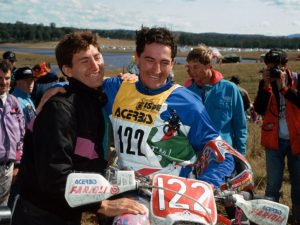
2. Was there a moment when you realised you were going faster than the others?
Like all riders I was starting to grow in experience and speed. When I was 18 I won my first Italian cadet championship in enduro, which I never expected, but all my friends in the village were dedicated to motocross so I had left enduro to dedicate myself to motocross as well.
I won a few regionals in motocross, but my ambition was to race at a high level. I got to run the highest Italian championship, but sadly, I was not a professional because every day I had to work in my family’s grocery store and therefore had little time to devote to weekly training.
Anyway, I finished the Italian Senior Championship in 12th position, and in 1999 I took part in a motocross world championship round in Czechoslovakia, in Dàlecin to be exact. I finished both rounds in 22nd position, which wasn’t bad for someone who sells salami……
As you will understand, with a grocery shop money was tight, and I had to put all my wages into the bike, parts, tyres and travel to races, so in 1990 I decided to quit motocross racing. I couldn’t spend everything to race motorbikes! But in that year I had tried to get back into enduro racing, which went quite well, so Ige Carrara, the owner of a KTM dealership, took me to Team Farioli, where ‘Boss’ Arnaldo Farioli opened my first contract as a KTM factory rider. It was 1991, so I was already 27 years old, but in good health and physique, and above all motivated like crazy, I started training seriously. Of course in the family shop I was no longer so regular in attendance, but when I was at home I continued to help the family.
3. So the KTM has changed your life, even though, and this does you credit, you’ve kept your feet on the ground from what you tell me… You’ve been (and continue to be today) a legend for entire generations of enduro riders and you’ve managed to conquer from the most seasoned to the youngest. KTM recently presented you with a special award in recognition of your career. I imagine that must have been a great satisfaction, tell us about it?
Yes, I am very happy with the recognition that KTM has given me! In the past it was me who gave KTM satisfaction, and now it is KTM that is rewarding me with various awards. One above all is certainly the fact that I have still been in the ranks of the Austrian brand for over 30 years! Furthermore, in Mattighofen at the Motohall I have a place in the hall of fame!
For sure, having started back in 1991 and finished with racing in 2007, I was able to go through a couple of generations of fans, then even after my sporting career I stayed on the wave of my sport by holding various positions, including Track Inspector for the FIM where I took care of the enduro world championship tracks, so I always remained in the environment and in contact with the fans.
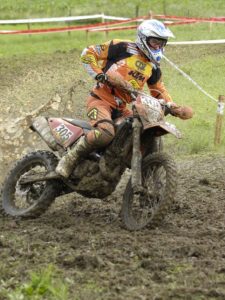
4. Do you remember the first time you stood on the podium? When was it and on what occasion?
Yes, but it was a very little race, with no titles, while at the first Italian Cadet championship, as I told you before, I didn’t think I had won and so I didn’t show up at the awards ceremony! The first World Enduro Championship race I won in 1991. Unfortunately Team Farioli, due to a problem with the organisers, did not allow me to go to the awards ceremony and collect the trophy, so that trophy is not in my possession. But then in the future I made it many times on podiums all over the world, and always with great satisfaction. I have to say, though, that in 2006, when I stood on the podium at the legendary race Paris Dakar I was so happy that I carried with me a sign, a piece of paper with the words ‘I am overjoyed’, in case anyone didn’t get it. I think though that seeing my face on the podium at Lago Rosa, there was no need for writing it down!
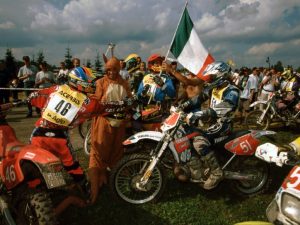
5. The races, the World Cup, even the Dakar! During these occasions, did you ever have a good luck charm, a number, an object, a routine that you carried or did all the time? Probably after your answer there will be many of us who will try to do the same thing, in the hope that it will work for us too?
Ouch, I disappoint you, I have never been superstitious and therefore no rituals or ceremonies, but I had a let’s say ‘strict’ line in my behaviour during the race. For example, when I was watching the special stages on the days preceding the race, when I was walking them, I didn’t tolerate being distracted with chitchats because I wanted to stay focused. Then, ‘woe’ if during breakfast before the race a journalist or a fan came to ask me questions, my head was already in the race and I didn’t feel like talking. Also, before starting the special I would shake my head so that the helmet would fit tightly around my face.
But as I said, nothing superstitious! Ah well, I always liked to use the same bag in the different seasons, at least until it wore out and broke, but more out of affection than superstition.
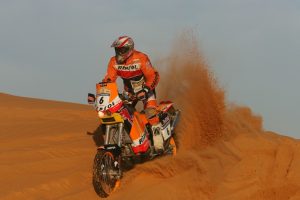
6. Well, next time I ride I’ll try scouting the head in the helmet, who knows, maybe it will work! But now let’s move on to another topic: how important is the bike’s performance, preparation and correct setting? Many of us spend hours finding the best suspensions… but does it really change that much? Or does he who is a top rider remain a top rider even on the tricycle?
When you race at a high level, performance is important, every detail counts to make a difference, so a good bike with a good rider will do better than a good rider with a mediocre bike. Of course in enduro 70% of the performance comes from the rider, but obviously when he has a good bike! The suspension setting is very important and fundamental, it allows you to go fast safely. You can’t have a bike that reacts badly when you’re going fast through potholes, roots, stones…….and you’re in the middle of trees!
Then of course the rider has to do his part when the bike is at the limit, correcting those situations where the suspension alone cannot solve the skid.
Obviously being a a top rider helps you go better even with a bike that is not super high performance, but if you want to win you need both.
7. We know that you still ride motorbikes, you are involved in most enduro events. For those who want to learn enduro technique directly from you, do you have any possibilities? Do you organise courses or tours?
I continue to ride because I really enjoy it, and now that I’m not racing I’ve rediscovered the pleasure of riding the bike without being in too much of a hurry, now I enjoy the routes, the views…….and the restaurants that we reach on the tour.
A few years ago I finished working for the International Federation as Track Inspector at the World Enduro Championship, now that I’m a father of a 10-year-old son I don’t feel like being away from home for so long. So as KTM Ambassador I take care of the routes of the KTM Enduro Trophy, a beautiful trophy that takes place in 5 stages in Italy and takes me just a few days of work. I then take part, riding the KTM 890R, in non-competitive events, events dedicated to twin-cylinder bikes, a segment that is becoming increasingly popular.
I no longer organise courses because unfortunately I’ve had bad experiences that have cost me a lot of money because of participants who try to take every possible opportunity to claim some money from the organiser. Now to teach a few tricks of the trade I get called in by motorbike clubs or KTM dealers who organise events for their customers. I participate as an instructor but no longer as an organiser.
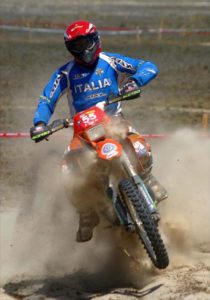
8. For those who don’t get a chance to attend the events where you teach in person… can you give any tips on how best to ride an enduro bike? Any secrets, any details that can help improve your riding skills a lot?
I find it a bit hard to explain the tricks of the trade by writing words, but the first piece of advice I give is to have fun, no matter how fast you go. As I told you before, I have a lot of fun now without going at race pace (also because I would no longer be able to). NDR: No way, we obviously don’t believe that at all!
Enduro presents so many different situations that even a manual would be ineffective in passing on advice. But I can give some hints… I might suggest riding standing on the footpegs instead of sitting down. In fact, if you look at all the off-road competitions such as Dakar, Motocross, Enduro, Extreme Enduro and Trial, all the champions ride mostly standing up. But… even here… if you don’t have the right technique, with weight shifting for example, standing can be inefficient and very tiring. One piece of advice I would give is to manage the engine’s power with the clutch, because with the throttle alone we’ll have an ‘on/off’ power situation, and in certain situations it’s not easy to dose the throttle to the millimetre, while the clutch allows us to give or take power away from the wheel.
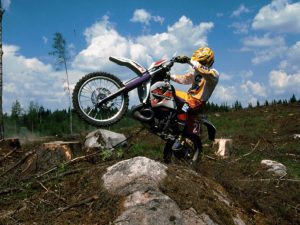
9. We will definitely go and test your advice Gio, thank you very much! I would go on and on asking you a thousand more questions but I know we have to close. So I’d ask you, again motorcycling-wise, if you could say one thing to yourself as a kid, what would it be?
I would say to myself, bravo Gio, do it again exactly as you did that everything went super well, also because I always knew that with ifs and buts history was never made.
And we also say:
Bravo Gio, you have definitely made enduro history and we are super happy to have met you. And what would we add to our readers? That it is rare to meet such humility, kindness and availability in a champion of Gio’s calibre. A big thank you for this interview and see you next time. We hope to be able to ask Gio a few more questions in the future. In fact, if you have any questions for him, send them to us and we will ask them for you.
We have invited Gio to enduro with us, from Enduro Experience Croatia, and we sincerely hope that sooner or later he will honour us with his presence. We will keep you updated! In the meantime, if you want to have fun enduro riding, we are waiting for you. Details at info@enduroexperience-croatia.com. And if you would like details of Gio’s activities, please visit his website http://www.giosala.com/.
Photos: Courtesy of www.giosala.com

